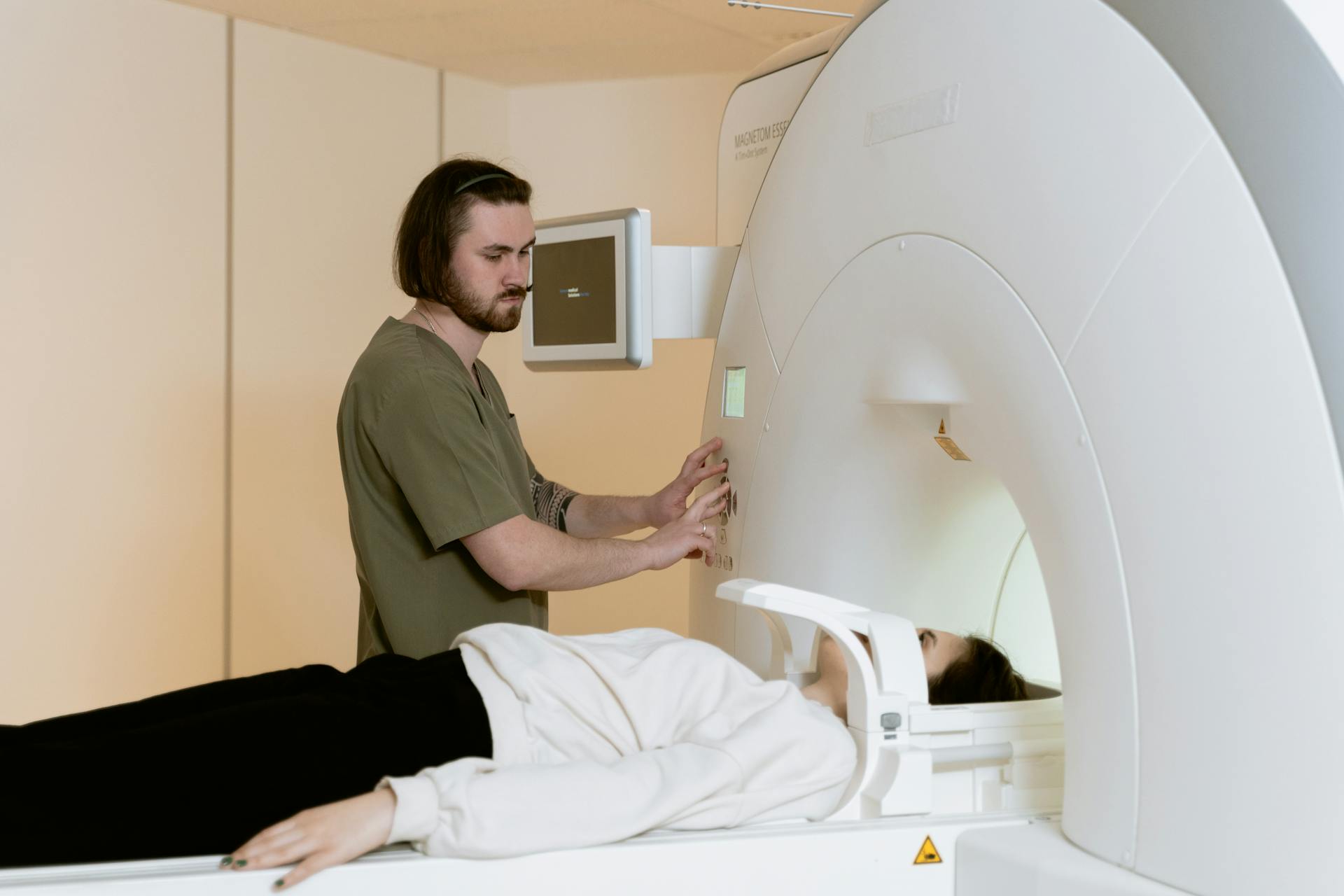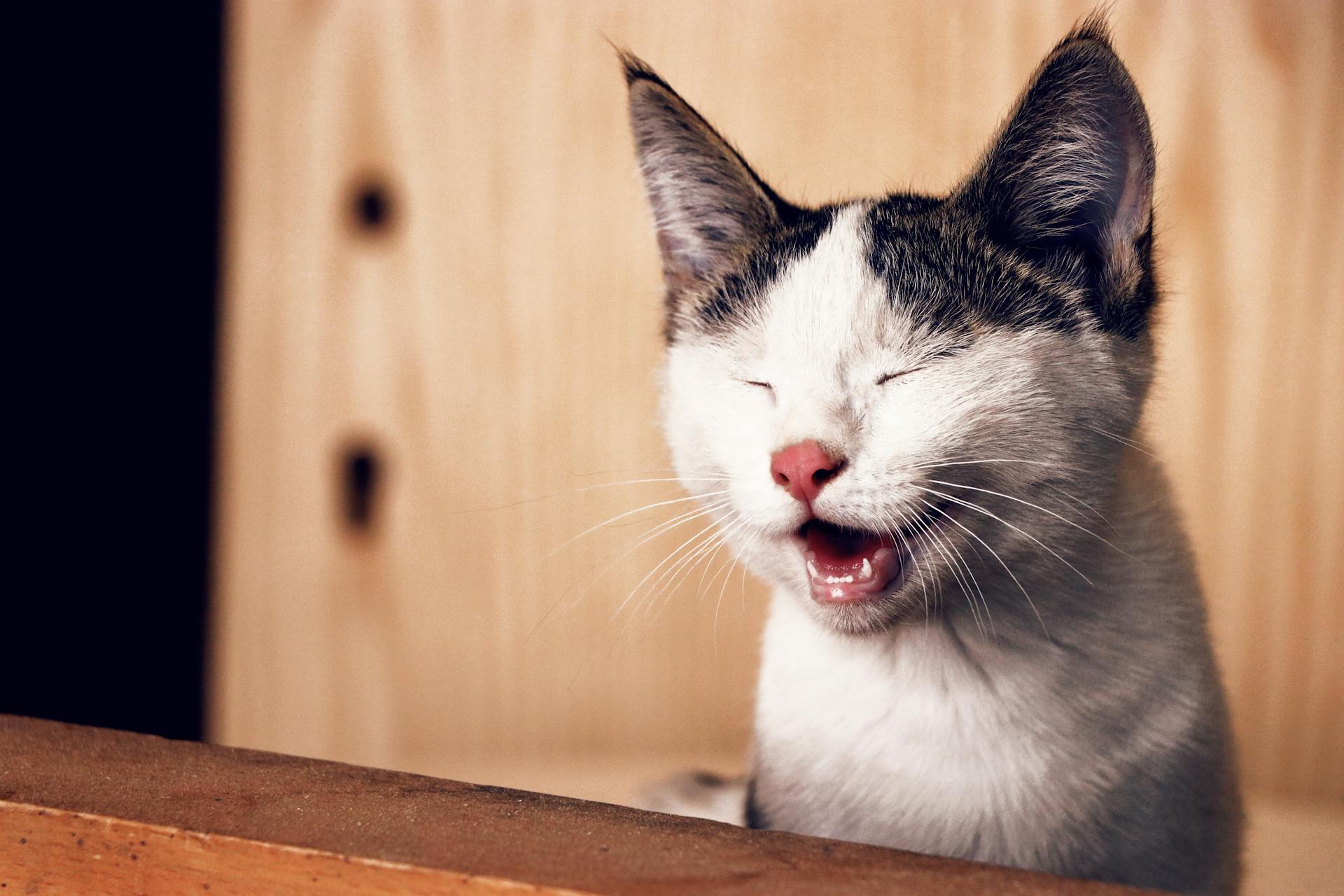
Laryngeal paralysis in cats is a serious condition that can be caused by a variety of factors, including infections, injuries, and degenerative diseases.
Infections such as upper respiratory tract infections can cause laryngeal paralysis in cats. This is often seen in cats that have a weakened immune system.
Cats with laryngeal paralysis may exhibit symptoms such as difficulty breathing, coughing, and blue-tinged gums due to lack of oxygen. These symptoms can be life-threatening if left untreated.
The severity of the condition can vary depending on the underlying cause and the extent of the paralysis. In some cases, the paralysis may be partial, while in other cases, it may be complete.
Intriguing read: Can Fleas Cause Paralysis in Cats?
What Is Laryngeal Paralysis?
Laryngeal paralysis is a condition that affects the nerves controlling the voice box in cats.
It occurs when the nerves that regulate the muscles of the larynx are damaged, leading to impaired vocal cord function.
This damage can cause the vocal cords to become paralyzed, making it difficult for cats to breathe, eat, and even produce sound.
The symptoms of laryngeal paralysis can include difficulty swallowing, panting, and a characteristic "stridor" sound when breathing.
In severe cases, cats with laryngeal paralysis may experience respiratory distress, which can be life-threatening if left untreated.
Causes and Risk Factors
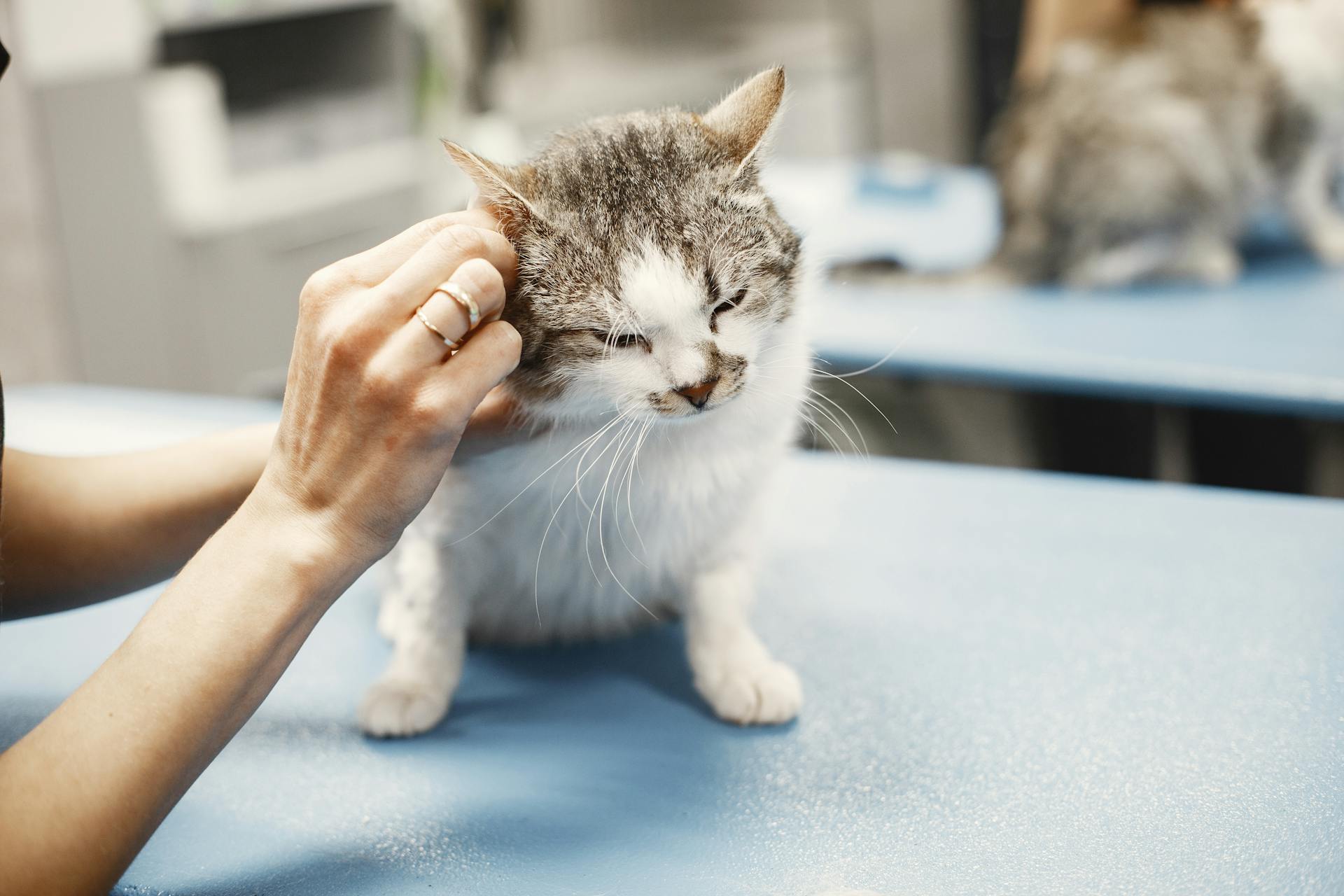
Laryngeal paralysis in cats can be caused by a range of factors, including abscesses or tumors in the neck or chest. These growths can compress the nerves controlling the larynx, leading to paralysis.
Trauma to the neck or throat area is another possible cause, which can damage the nerves and muscles controlling the larynx. This can result from accidents, surgeries, or physical abuse.
Obesity in cats can make laryngeal paralysis worse, even if it doesn't directly cause the disorder. This is an important consideration for cat owners, especially those with overweight pets.
Some cats may be born with congenital defects affecting the laryngeal nerves or muscles, leading to paralysis from a young age. These defects can be a significant risk factor for laryngeal paralysis.
Here are some potential causes of laryngeal paralysis in cats:
- Abscesses or tumors of the neck or chest
- Trauma (injury to the nerves of the larynx)
- Neurological conditions (such as polyneuropathy or myasthenia gravis)
- Abnormalities of the muscles (myopathy)
- Congenital birth defect
- Idiopathic (unknown)
Causes
Laryngeal paralysis in cats can be caused by a variety of factors, including abscesses or tumors in the neck or chest. These growths can compress the nerves controlling the larynx, leading to paralysis.
Trauma to the neck or throat area is another possible cause. This can result from accidents, surgeries, or physical abuse.
Nervous system disorders, such as issues with the nerves that supply the muscles of the larynx, can also lead to laryngeal paralysis. These conditions disrupt the nerve signals necessary for proper muscle function.
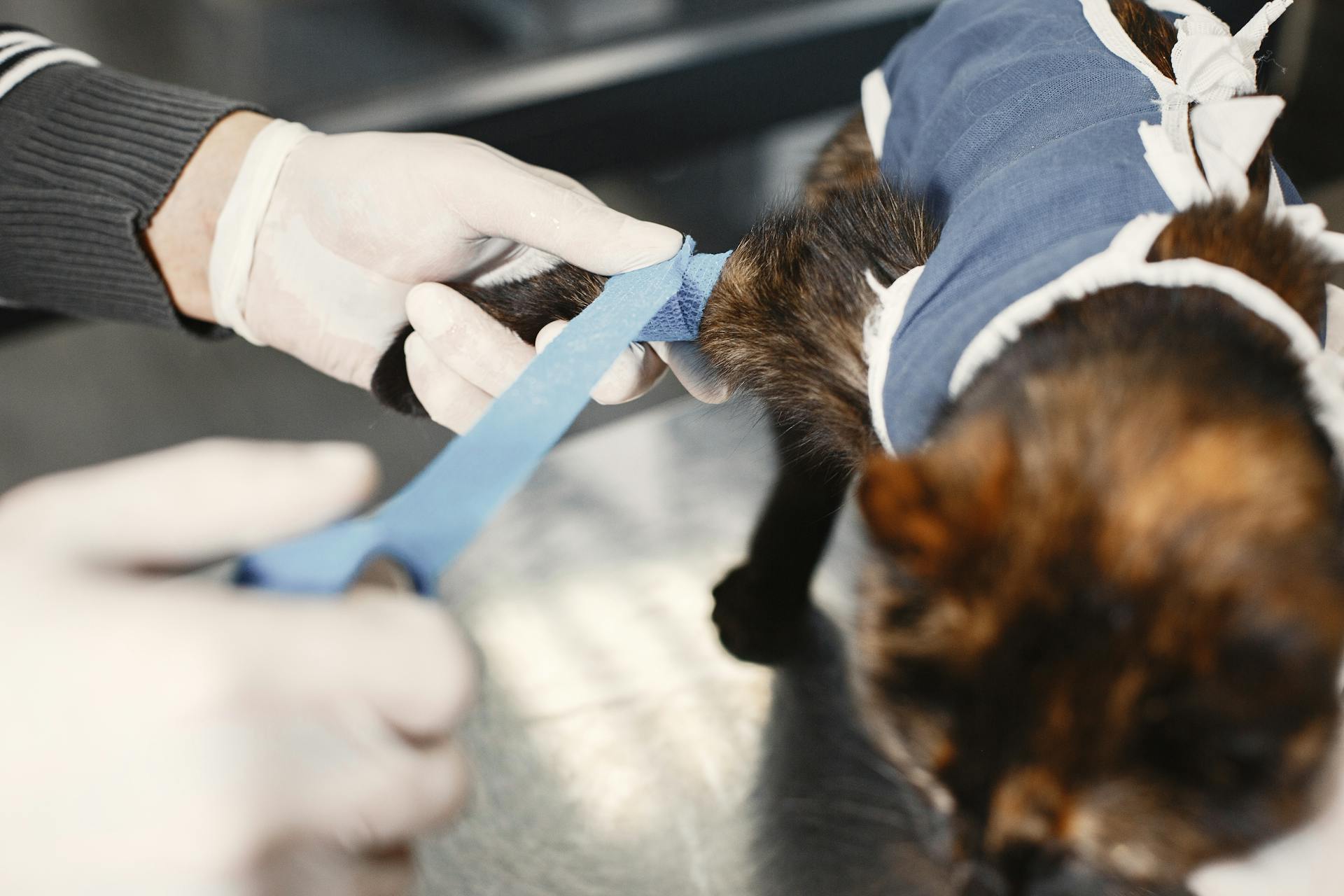
Some cats may be born with congenital birth defects affecting the laryngeal nerves or muscles, leading to paralysis from a young age. This is a rare occurrence, but it's essential to be aware of the possibility.
Hypothyroidism, or low thyroid levels, can also contribute to the development of laryngeal paralysis. However, this is rare in cats.
Obesity in cats can make laryngeal paralysis worse, even if it doesn't directly cause the disorder. Maintaining a healthy weight through a balanced diet and regular exercise can help minimize this risk.
Here are some possible causes of laryngeal paralysis in cats:
- Abscesses or tumors of the neck or chest
- Trauma (injury to the nerves of the larynx)
- Nervous system disorders (issues with the nerves that supply the muscles of the larynx)
- Abnormalities of the muscles (myopathy)
- Hypothyroidism (low thyroid levels)
- Congenital birth defect
- Idiopathic (unknown)
Risk Factors
Certain lifestyle choices can significantly increase the risk of developing the condition. Smoking is a major risk factor.
People who are overweight or obese are more likely to develop the condition. This is because excess weight can lead to insulin resistance, a precursor to the condition.
Genetics play a role in the development of the condition. If you have a family history of the condition, your risk is higher.
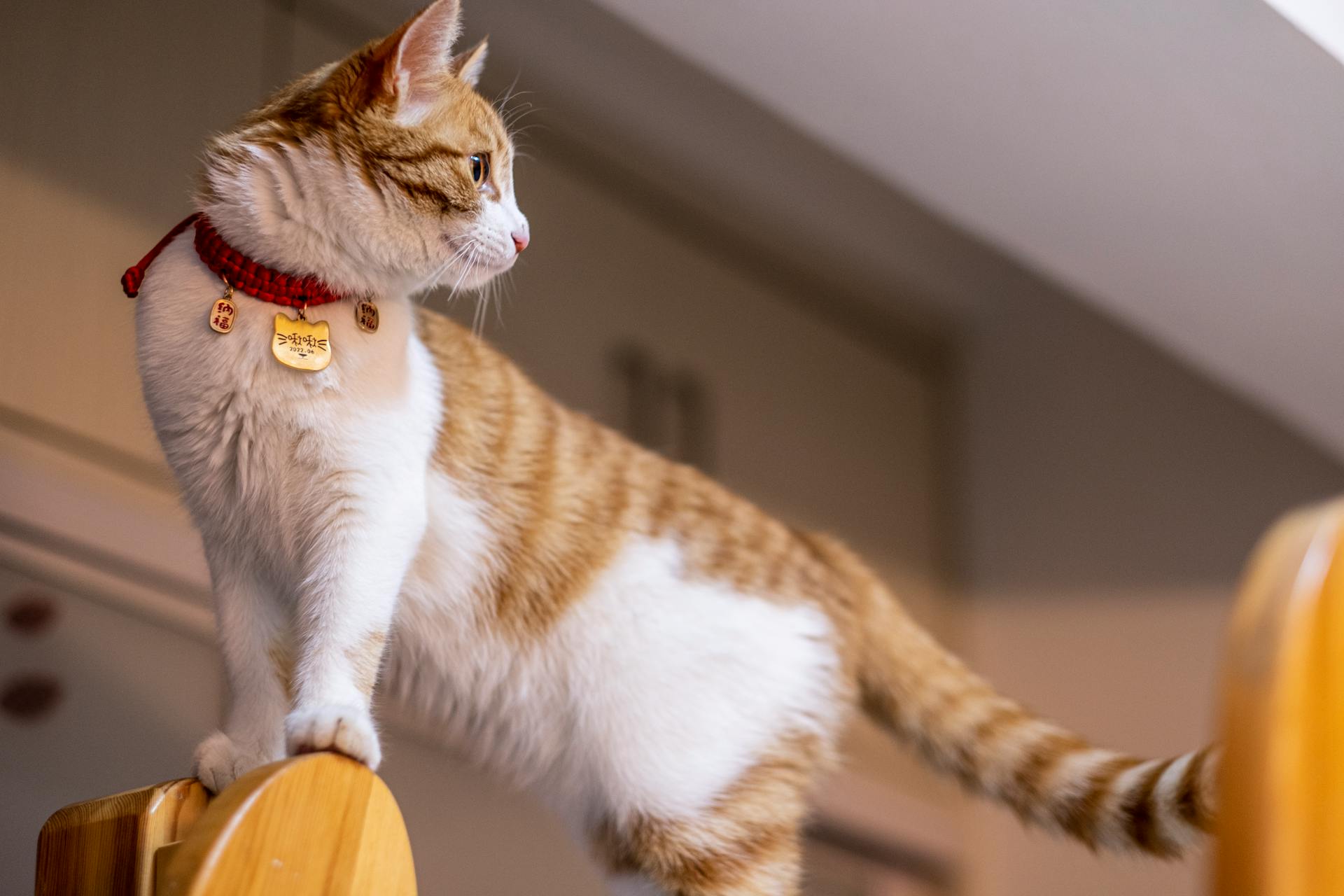
Stress can exacerbate symptoms and worsen the condition. This is because stress hormones like cortisol can raise blood sugar levels and worsen insulin resistance.
A diet high in processed foods and sugar can increase the risk of developing the condition. This is because these foods can cause a spike in blood sugar levels and lead to insulin resistance.
Diagnosis
If your cat is showing signs of respiratory distress or trouble breathing, seek veterinary attention right away. This is crucial for a quick and accurate diagnosis.
A tentative diagnosis of laryngeal paralysis may be made based on a physical examination, including listening to your cat's heart and lungs, and the presence of inspiratory stridor, a high-pitched vibrating noise when your cat is breathing in and out.
To confirm the diagnosis, a procedure called laryngoscopy is necessary. This involves sedating your cat and visualizing the larynx with a laryngoscope or endoscope to check if the larynx is opening properly during inspiration.
Neck and chest X-rays will likely be performed to rule out aspiration pneumonia and look for signs of a mass or tumor.
Treatment Options
Medical management is a crucial first step in treating laryngeal paralysis in cats. This approach focuses on reducing inflammation, improving airflow, and addressing secondary infections.
Anti-inflammatory medications like steroids or other anti-inflammatory drugs can help reduce inflammation around the larynx and improve airflow. Antibiotics may be prescribed if there is a secondary infection in the airway. Bronchodilators can help open the airways and improve breathing. Sedatives or anxiolytics can be used to calm a cat experiencing anxiety or distress due to breathing difficulties.
Weight management is essential to reduce the strain on the respiratory system. Keeping your cat at a healthy weight can make a big difference in their overall health. Ensuring a cool, stress-free environment can also help manage symptoms. Avoiding hot and humid conditions is crucial.
Feeding adjustments can also play a role in managing laryngeal paralysis. Feeding your cat smaller, more frequent meals and elevating food and water bowls can reduce the risk of aspiration. This is especially important for cats with laryngeal paralysis.
Surgical intervention may be necessary in severe cases where medical management is insufficient. The most common surgical procedure is a "unilateral arytenoid lateralization", commonly known as a "tie-back" surgery. This procedure involves permanently suturing one side of the larynx open to allow better airflow.
In mild cases, supportive care such as steroids or sedatives/tranquilizers may be used to help keep the inflammation and swelling down and help the cat to relax and improve overall breathing. However, as the disease progresses, these treatment options will be insufficient and the cat may experience respiratory distress.
Recovery and Management
After surgery, your cat will need to rest and recover for 10 to 14 days, with restricted activity to prevent complications.
During this time, it's crucial to monitor your cat's behavior and watch for signs of aspiration pneumonia, which can be deadly if left untreated. These signs include lethargy, weakness, fever, cough, decreased appetite, and increased respiratory rate and effort.
Your cat may not show noisy breathing, but other symptoms can be more subtle. If you notice any of these signs, seek veterinary attention immediately, as aspiration pneumonia requires antibiotics and possibly hospitalization for IV fluids and oxygen support.
Recovery Time
You'll want to keep a close eye on your cat during the recovery period, which typically lasts around 10 to 14 days. They'll need to rest and avoid strenuous activity during this time.
Cats that undergo surgery for laryngeal paralysis usually need to stay in the hospital for one to two days after surgery. They'll be on IV fluids and pain medication during this time.
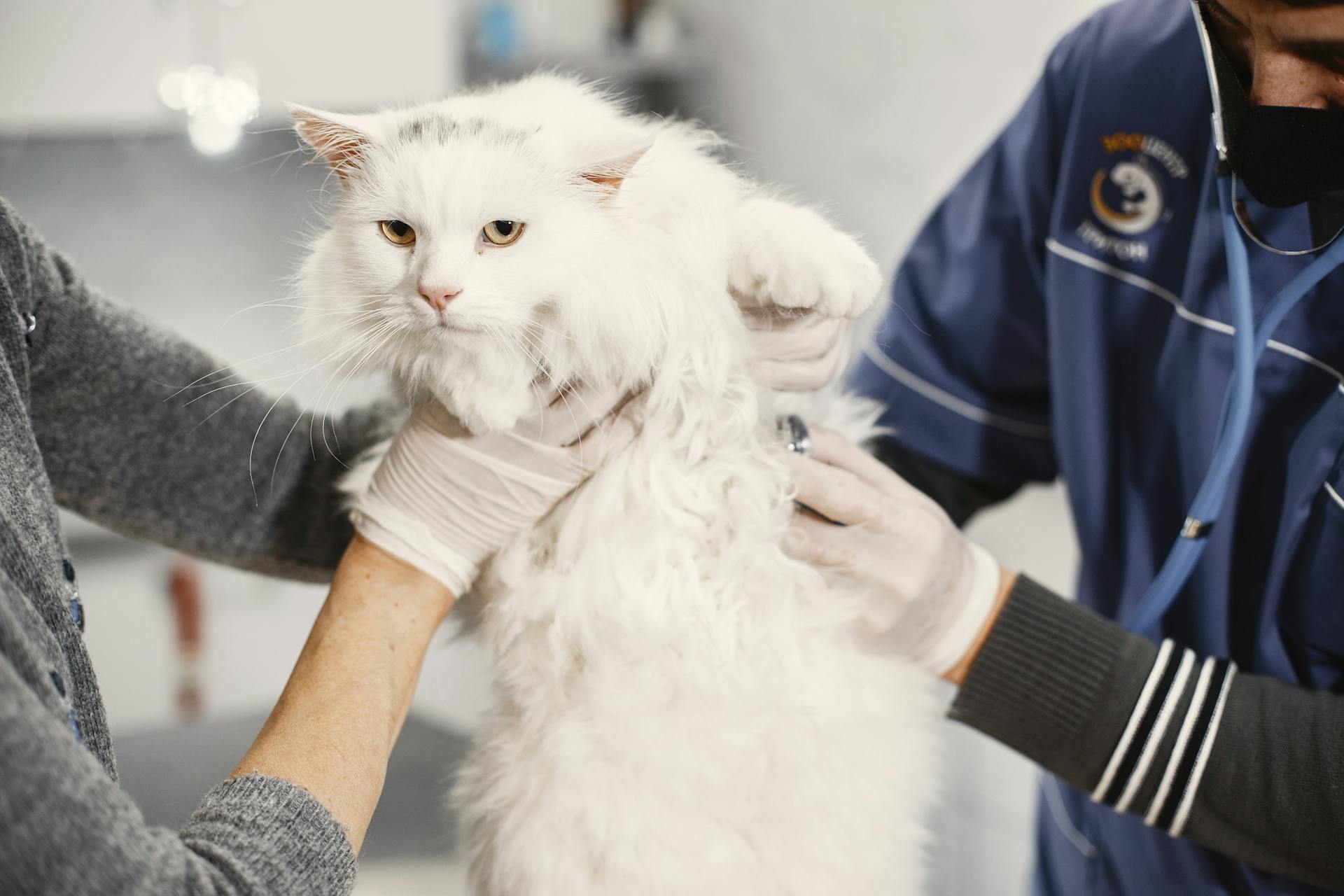
Once they're discharged, you'll want to monitor them for any signs of aspiration pneumonia, which can be deadly. This includes lethargy, weakness, fever, cough, decreased appetite, and increased respiratory rate and effort.
Your cat will typically be able to resume normal activity after 14 days of rest and restricted activity. However, it's crucial to keep a close eye on them during this time and seek immediate veterinary attention if you notice any signs of aspiration pneumonia.
Long-term Management
Long-term management is crucial for a successful recovery.
A well-structured plan can help individuals stay on track and avoid relapse. This plan should include regular check-ins with a therapist or support group, as discussed in the "Support System" section.
Regular exercise, such as walking 30 minutes a day, can also help manage stress and anxiety.
A healthy diet, including foods high in omega-3 fatty acids, can support brain health and improve mood. This is especially important for individuals with mental health conditions, as seen in the "Nutrition and Mental Health" section.
You might enjoy: Non Surgical Treatment for Laryngeal Paralysis in Dogs
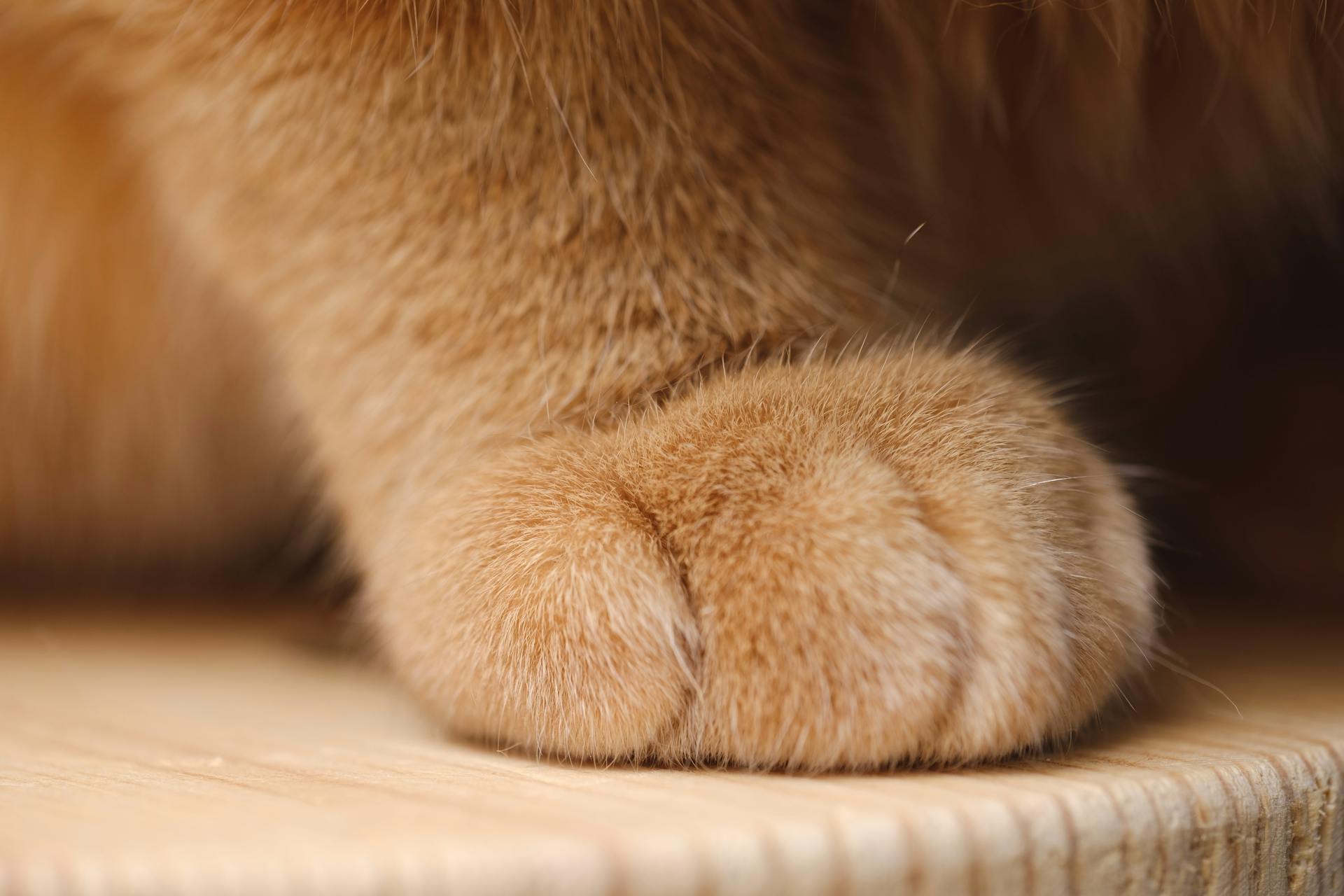
Staying organized and prioritizing tasks can also help individuals manage their time effectively and reduce stress. This can be achieved by breaking down large tasks into smaller, manageable chunks, as discussed in the "Time Management" section.
Adequate sleep, such as 7-8 hours per night, is also essential for overall health and well-being.
How Long Can You Live
Living with laryngeal paralysis can be a manageable condition with the right care. Early detection and treatment are crucial for improving the prognosis, and cats diagnosed and treated early may have a better quality of life and longer lifespan.
The condition is typically chronic, requiring ongoing management through regular veterinary check-ups and monitoring of symptoms. Adherence to treatment plans is essential for managing the condition effectively.
With appropriate medical management and, if necessary, surgical intervention, many cats can lead relatively normal lives. This means that with the right care, cats can live for a significant amount of time after diagnosis.
Laryngeal Anatomy
The larynx in cats is a complex structure that plays a crucial role in respiration. It's made up of cartilages that open and close during breathing.
The cartilages of the larynx are responsible for controlling airflow in and out of the lungs. This process is essential for maintaining normal breathing patterns.
In cats with laryngeal paralysis, these cartilages do not function properly, leading to breathing difficulties.
Explanation
The larynx, or voice box, is a complex structure that plays a crucial role in our ability to speak and breathe. It's made up of several key components, including the epiglottis, vocal folds, and arytenoid cartilages.
The epiglottis is a flap-like structure that separates the trachea from the esophagus, preventing food and liquids from entering the airway. It's a vital function that's essential for our survival.
The vocal folds, also known as vocal cords, are two bands of muscle tissue that vibrate to produce sound when we speak or sing. They're located in the larynx and are made up of mucous membranes and muscle fibers.
The arytenoid cartilages are a pair of small cartilages that are located on either side of the vocal folds. They play a crucial role in the opening and closing of the glottis, which is the space between the vocal folds.
The larynx is also home to the cricoid cartilage, which is a ring-like structure that surrounds the trachea. It's a vital part of the laryngeal anatomy and helps to support the other structures in the larynx.
Surgical Anatomy
The larynx, also known as the voice box, is a critical part of a cat's upper airway. It's located at the top of the trachea.
In cats, the larynx is made up of cartilages that don't open and close normally during respiration when they have laryngeal paralysis. This condition is rare in cats.
The cartilages of the larynx are responsible for controlling airflow in and out of the lungs. They don't function properly in cats with laryngeal paralysis.
A veterinarian will typically use an endoscope, also known as laryngoscopy, to examine the upper airway and confirm a diagnosis of laryngeal paralysis. This procedure is done under light anesthesia.
Symptoms and Signs
Laryngeal paralysis in cats can be a challenging condition to diagnose and manage.
Cats with laryngeal paralysis often experience a change in their voice, such as hoarseness or loss of vocalization.
Difficulty breathing is a common symptom, especially during physical activity or in hot, humid weather. Cats may exhibit noisy breathing, wheezing, or a high-pitched sound known as stridor.
Cats with laryngeal paralysis may cough or gag frequently, especially when eating or drinking, due to the inability of the larynx to protect the airway adequately during swallowing.
Affected cats often show signs of exercise intolerance, becoming easily fatigued or breathless after minimal physical exertion.
In severe cases, cats may develop cyanosis, a bluish discoloration of the gums and tongue, indicating inadequate oxygenation.
Some cats may have trouble swallowing, leading to weight loss and decreased appetite.
Treatment and Care
Supportive care such as steroids or sedatives/tranquilizers may be used to help manage mild cases of laryngeal paralysis, but these treatment options will be insufficient as the disease progresses.
In severe cases, cats may require sedation, oxygen supplementation, and intubation to stabilize and allow them to breathe. Respiratory distress is a sign that immediate veterinary evaluation is necessary.
Medical management is a key part of treating laryngeal paralysis, and may include anti-inflammatory medications, antibiotics, bronchodilators, and sedatives or anxiolytics. These medications can help reduce inflammation, open airways, and calm a cat experiencing breathing difficulties.
To manage symptoms, keeping a cat at a healthy weight is crucial, as excess weight can strain the respiratory system. A cool, stress-free environment is also essential, and avoiding hot and humid conditions can help alleviate symptoms.
If medical management is insufficient, surgery may be necessary to improve airflow. The most common surgical procedure is a "tie-back" surgery, which involves permanently suturing one side of the larynx open to allow better airflow.
Veterinarian's Role
As a pet owner, it's essential to understand the veterinarian's role in providing treatment and care for your furry friend. Veterinarians are medical professionals who specialize in the health and well-being of animals.
Their primary responsibility is to diagnose and treat illnesses and injuries in animals, just like human doctors do for people.
Veterinarians must stay up-to-date with the latest medical research and technologies to provide the best possible care for their patients. They often work long hours, including evenings and weekends, to accommodate pet owners who need urgent care.
Veterinarians use a variety of diagnostic tools, such as X-rays, blood tests, and physical examinations, to determine the cause of an animal's illness or injury.
They also provide preventative care, such as vaccinations and check-ups, to help keep pets healthy and prevent diseases.
In addition to medical care, veterinarians often provide advice on nutrition, behavior, and other aspects of pet care.
Supportive Care
Supportive care plays a crucial role in managing the symptoms of laryngeal paralysis in cats.
Initially, supportive care such as steroids or sedatives/tranquilizers may be used to help keep the inflammation and swelling down and help the cat to relax and improve overall breathing.
In mild cases, these treatment options can be effective, but as the disease progresses, they may become insufficient.
Cats with respiratory distress or trouble breathing require immediate evaluation by a veterinarian.
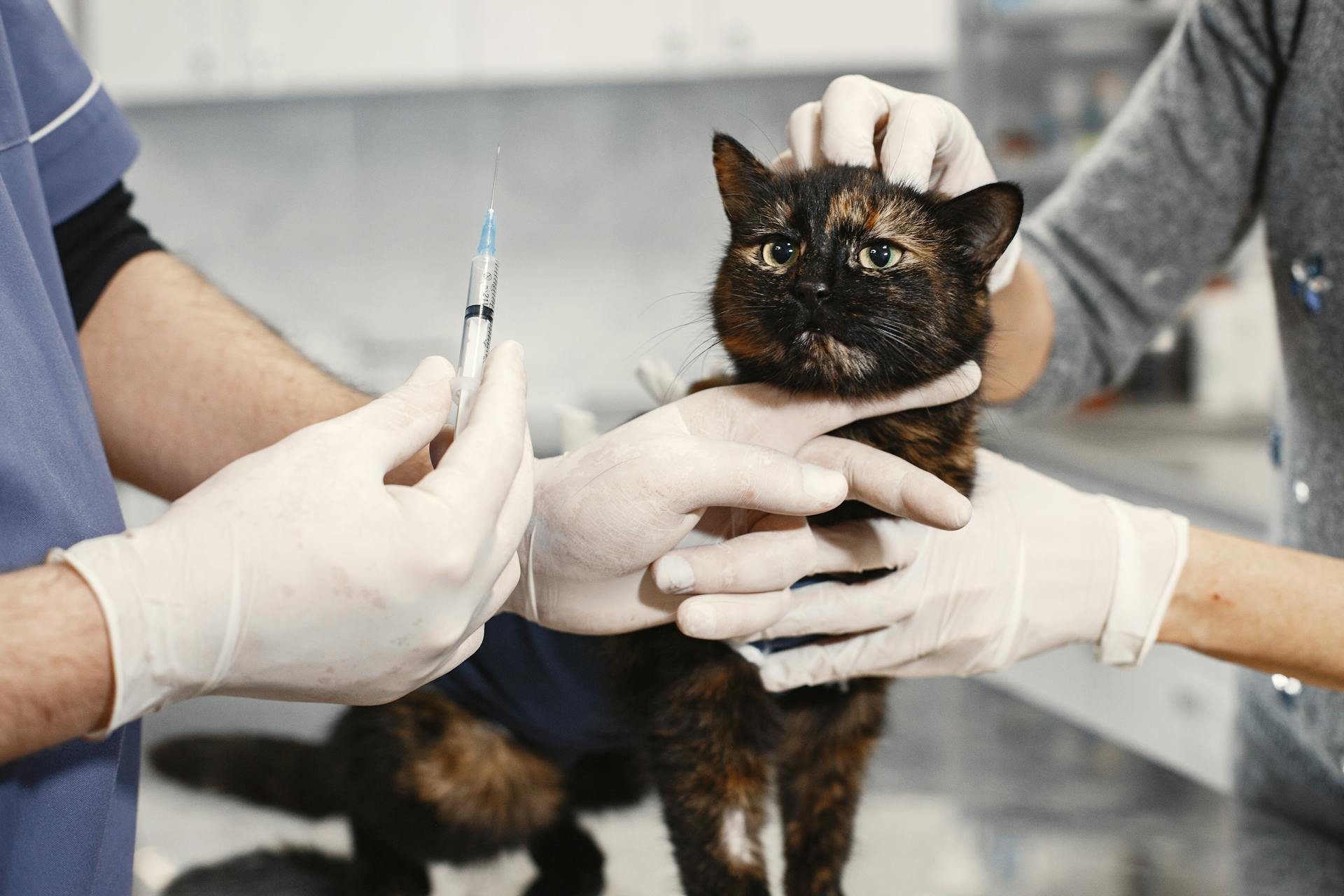
Supportive care may include cooling the cat if it has overheated or IV fluids if the cat has become dehydrated.
Here are some common supportive care options:
- Steroids to reduce inflammation
- Sedatives or tranquilizers to calm the cat and improve breathing
- Oxygen supplementation to help the cat breathe
- IV fluids to prevent dehydration
- Cooling to prevent overheating
Can It Heal Alone?
Laryngeal paralysis in cats doesn't typically heal on its own. In fact, the condition often requires medical or surgical intervention to manage symptoms and improve quality of life.
Laryngeal paralysis is a progressive condition, meaning symptoms can worsen over time. Without treatment, severe respiratory distress and potentially life-threatening complications can occur.
Effective management usually involves medical treatment to alleviate symptoms. In severe cases, surgical intervention may be necessary to restore adequate airflow.
Early and proactive treatment is essential for preventing the progression of the disease. This is crucial for maintaining the cat's quality of life.
Frequently Asked Questions
How long does laryngeal paralysis last?
Laryngeal paralysis typically progresses slowly in older patients, allowing them to live a normal lifespan before further symptoms arise. However, the duration of the condition can vary depending on individual circumstances.
Sources
- https://www.petmd.com/cat/conditions/mouth/laryngeal-paralysis-cats
- https://www.merckvetmanual.com/cat-owners/lung-and-airway-disorders-of-cats/laryngeal-disorders-in-cats
- https://pubmed.ncbi.nlm.nih.gov/10754671/
- https://puainta.com/blogs/cats/laryngeal-paralysis-in-cats
- https://veteriankey.com/larynx-2/
Featured Images: pexels.com

